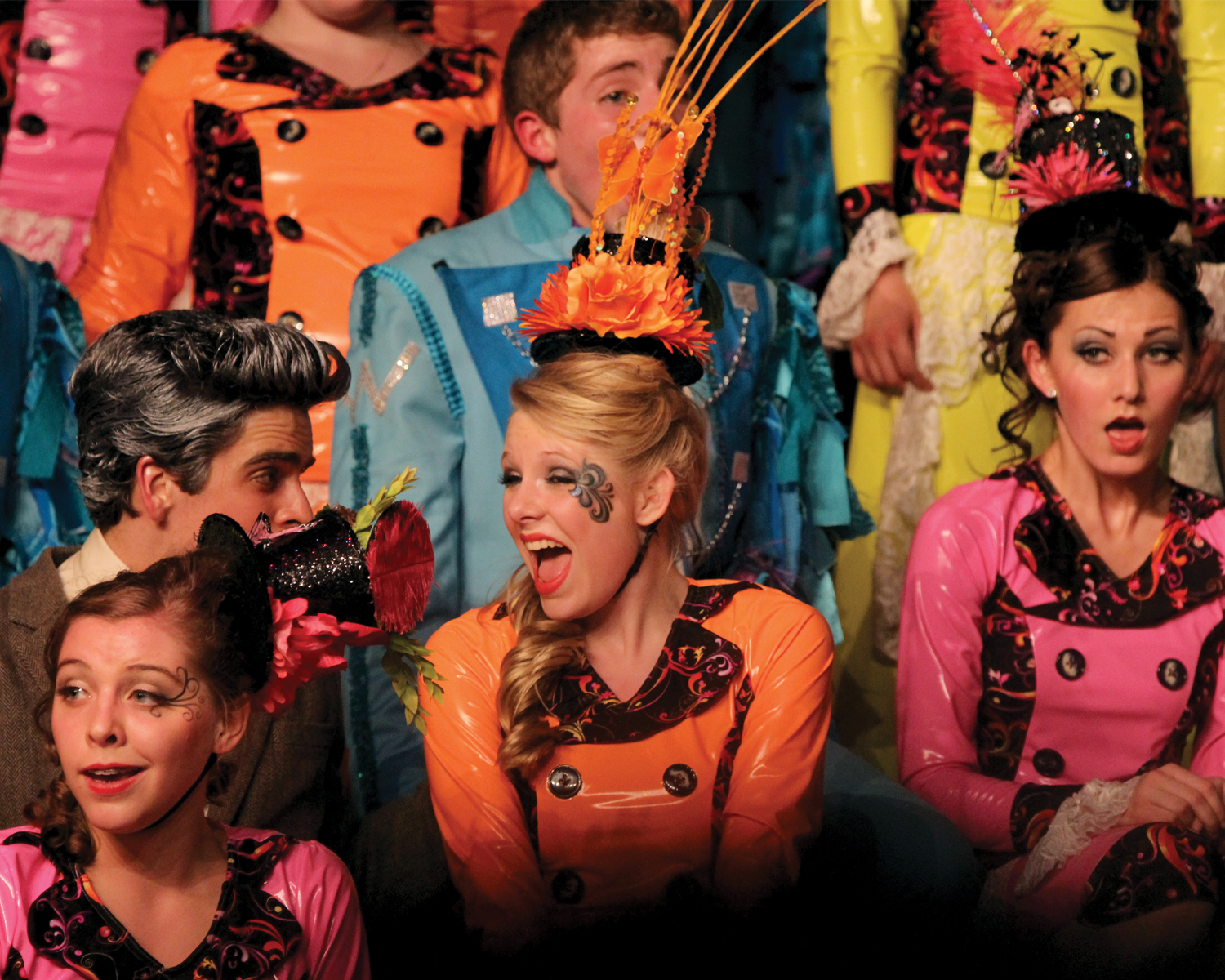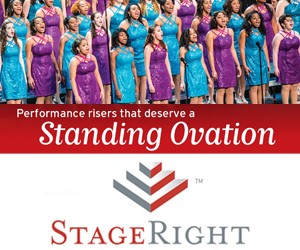
Five Building Blocks for Award Winning Show Design
Rick Lunt, Director, Evolution (UT)
Evolution, American Leadership Academy’s mixed show choir, was awarded the Best Show Design in April 2014 at the FAME Nationals in Chicago. As a director, I saw this as a great accomplishment, requiring much foresight, planning and development.
Brainstorming a show design starts in the spring after our final competition. The past couple of years we have centered our shows after two movies: Willy Wonka and Monsters, Inc. The choir members often provide ample ideas; however, the final decision must be up to the director and show design team.
One must first determine if the design will have a storyline, theme, or typical Midwestern show with five songs. Having designed each of the above show styles, I have determined five building blocks that will aid in providing an award-winning show choir set design.
- Pinpointing a Theme: Many directors may find a specific song to plan a show around. However, I have determined that it is important to motivate and teach a life skill. Find a story, movie, or musical that has a great plot with an even better lesson. Realize that while you will not have time to tell the complete story in 20 minutes, you can design a show that will motivate, move, and inspire.
- Select Appropriate Music: Each year, my wife asks why I have purchased nearly 50 songs on iTunes. It is important to look at a variety of music that will not only aid in your plot, but will provide diversity and musical variety. It is important to select some current repertoire that the students will be excited about, along with selecting others that mature audiences may relate to also.
- Collaborate: It is imperative to share your new show design with your team, allowing more eyes on the show design and a critical evaluation of the project up to that point. Someone might have a clearer vision, a different song choice, or a twist to add. Allowing others in your process is not only engaging and vital, but it also helps them choreograph or write arrangements with the complete vision in mind.
- Plan Your Costumes, Set, and Band: Considering your costume design, costume changes, and band members’ abilities is crucial. Thorough set designs that have included costume design, costume changes, band abilities, and solid band arrangements will produce excellence.
- Sharing: Alumni often will share their life lessons learned in choir. Provide opportunities for this by allowing students to share with each other what they are learning from the text, from the plot, or this year’s choir experience.
A Technical Designer’s Planning Process
Keith Stevens, Technical Designer, John Burroughs Powerhouse (CA)
The most important thing as a technical director is to make sure we do no harm-just like a doctor’s creed. Our goal is to ensure that what we do will only add to the experience in a way that stays within what was originally envisioned.
As you could imagine, the Booster Club members at John Burroughs are very supportive, with people giving hundreds of hours a year to make it possible. We are also fortunate to have an amazing ROP technical program run by Jon King, two classes which include over 50 students whose main focus is stagecraft- lighting, sound, set construction, painting and rigging.
Several things are considered while we plan our backdrops and effects. First, we evaluate the venues that we will be performing in, the size of the stage (width, depth, and height), and the dimensions of the entrances (including possible elevators). We ask ourselves how we will transport the equipment? We determine electrical wattage and number of amps. We ask if they will allow atmosphere (HAZE) compressed gas, fire extinguishers (co2), dry ice (fog) and confetti. Just as importantly, we learn how long we will have to set up and breakdown, and if they will assist. We ask if riser setup will count in our time, if we will encounter a union house, and if there are steps. This is just a partial list of items that goes through our minds when designing a production.
Through the year I often find myself daydreaming, staring at something on the street (a billboard, some new lighting effect, etc.) that catches my eye. I look at it in a way that few probably do. Will that work on stage? How will it look? Will it fit? How fast can we set it up and break it down? I look forward to going to professional musicals and CIR QUE types of shows just so I can see what they are using. Sometimes I just watch in awe and wonder, “What if?”
Set Design as Show Design
Terry Voss, Director, Company of Singers (MN)
Show Design is one of the areas I enjoy the most. Even though I work with several other instructors, I primarily come up with the show ideas. Sometimes it can be drive by costume, theme or even a particular song, but it always has the same thread- audience appeal.
I have usually been successful at choosing shows that appeal to the “masses” because I try to keep my audiences in mind. For instance, when we perform for senior citizens, I find something that is nostalgic; for younger crowds, I arrange something hip enough for “kids” and then something reminiscent for parentaged audiences.
Of course, costuming and staging are important considerations as well. Though many groups sometimes push the “is it appropriate for high school?” envelope, the intention is for the costumes to “light-up” the stage; color and creativity appeal to all types of audiences. I can also say that my show designs are planned to entertain participants and audiences. I do not plan to the judges or ballot. Lastly, under strong consideration in the planning of a show is this question: Can I live with this show for what can be a year?
The Show Drives Set Design
Brett Carroll, Director, Burbank’s In Sync (CA)
At Burbank High, the show drives what we do with our set design. Rather than getting stuck doing a “this is what we do every year” set design, we try to think about what fits the show aesthetically and how we can fit it into our budget. Each year is such a different animal, and it almost feels like reinventing the wheel each time! It’s hard work, but it pays off when you know you’ve helped communicate the show’s story.
It’s important to consider what the set design is going to do for the show. Is it going to merely be a static scenic background, or is it going to have a fluid integral role in the performance? In the past, our shows have used set designs as simple as “nothing” (literally.nothing on stage except risers) all the way to a full wall of LED panels that are choreographed to the show’s music. Usually, we try to use something that propels our story and sets the atmosphere.
Once we know what our show is about and what we want to portray, we decide what we can build and how it will transport. Getting on and off stages quickly is probably the toughest part of designing a visual set. During competition season, we never know how difficult the venues will be and how we will load in/ out. Most of our California competitions are held in auditoriums, presenting challenges due to limited backstage storage space and maneuvering through backstage doors; we have done “gym style” competitions in the Midwest, which often offer more room to get to a stage and to exit the performing venue. Basically, we have to be prepared to get everything through a standard size doorway. That can be tough when you have a full row of footlights for downstage, multiple light trees lining the sides of the risers, and an entire truss system in back with a full LED wall!
Speaking of LEDs, our Burbank team used one of the first fully programmed and choreographed LED displays in show choir. Using that kind of technology isn’t for the fainthearted. I was terrified the tentire time that something would go wrong and that they wouldn’t be “synched” correctly throughout the performance. We were fortunate we never had a major disaster and the show (with themes of man vs technology) was enhanced by the lighting. A few years later, our “Prodigal” show pushed the technology even further and featured video content that was programmed to perform non-stop throughout the show. I was customized by a video content designer and created to follow exactly every change in the music including choreography accents. It was a huge undertaking but, once again, it fit a show that featured futuristic “robot toy” kids in a fantasy world.
However, the year after “Prodigal” we produced the “Civil War” set which was the “anti-technology” show. The only physical backdrops were two big flags that represented the North and the South. That was it. The biggest movement back there was when the flags dropped during the song “Crossroads” (which was when the soldiers decided which side to fight for)! The show wouldn’t have made sense with overwrought lighting and lots of technology; the show was better served by something simple and symbolic. The point really isn’t to see how much money you can spend. It really needs to be about what supports the show and enhances the performance. In the end, it IS all about the singers and what they are doing on stage. Whatever you do, no matter how big or small, if it complements the performers.it’s a winner!
Parents as Set Designers
Kaitlin DeSpain, Director, Red Hot Show Choir (WV)
When it comes to show design, there is no “formula” that I follow as a director, and that extends to set design as well. The purpose of the set is always to enhance the show, but not steal focus. I maintain that a choir should be able to perform their show without a set and flashy costumes and still be just as interesting. If they aren’t, they aren’t doing their jobs as performers.
I personally have almost no hands-on involvement in the building of the set, though this was not always true. During the beginning of my directing career (with the ARTS All Star Show Choir), I remember staying up until the morning light working on last minute set building and repairs! These days I have a great set of parents who make my visions come to life. This year I literally handed them a sketch (very poorly drawn, mind you) and said, “Make this happen.” If I still had that sketch I would send you a picture; they practically pulled the picture off the page!
Jim Fankhanel, the parent in charge of the set committee, shares that “our motto this year was measure twice and build three times!” He also shares that the choir is “blessed with a great crew of dads that work tirelessly to make the set the best they can” as their way of showing support and love for their children.
A Collaborative Approach to Scenic Design
Michael Sferro, Scenic Designer, Encore Entertainment Co. (OH)
Scenic design in Medina is relatively new to us. James Welch and I began working with Encore in 2009, after one of the Encore parents enjoyed our work that we provided to the musicals at Medina. Our work has evolved over time, but the approach has always been that our scenic designs were never the focus; they only enhanced the overall show, providing a backdrop that would drive the story and message of the show that the singer-dancers were working to tell. With that approach in mind, we were mindful to provide designs that were never distracting.
One of the most critical aspects of our work is that the student tech crew assists in creating the set and is 100% on their own when assembling it at competitions. We made a decision that our kids would be trained well enough that we would only support them from the audience, while they did everything on their own during the show. They are split between costumes and scenic duties, and each has an assigned task. We rehearse the crew just like the singer-dancers rehearse, training them on every contingency when we are at a competition and how to back up one another’s jobs if the need arises.
Over time James and I have crafted our own design-language in set design. It began with wooden scenery and traditional sparkly fabric and has evolved into the sculptural/metallic designs we have used since 2011. My primary background is in lighting design, and last year I was able to bring this into our set with “The Phoenix.” The set was all plasma-cut metallic “feathers” that James created, along with the ingenious system to transport them so they would fit on the truck, through doorways, all while being quickly assembled and torn down while the crew is on the clock. I incorporated a full LED lighting system into this year’s set, and James, Katie (our asst. director) and I programmed the hundreds of light cues required to complement the show.
We were very careful that the lighting-just like the set itself- assisted with the story, never coming out of the texture. The color choices, fades, bumps, and two short chases we used were all intentional and carefully planned, down to the measure of music each corresponded to. We trained a student to execute the light cues during the competition show, which she did flawlessly all season. Consistency and reliability were critical as we created this design.
Both our set and tech crew were recognized with awards this past season-which was thrilling for us. We are mindful, however, that we can’t have one without the other. An incredibly strong, professionally-trained crew and a high-level set design only exist if they work in concert.











